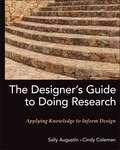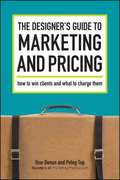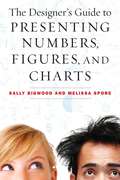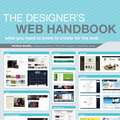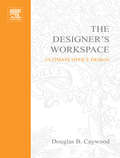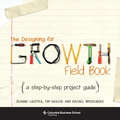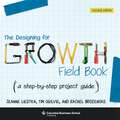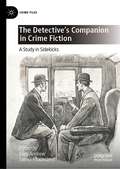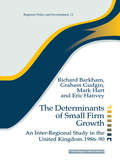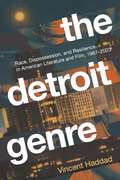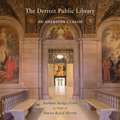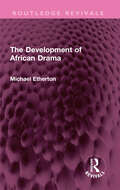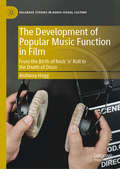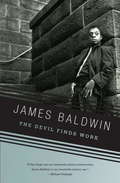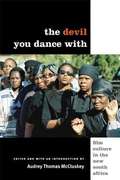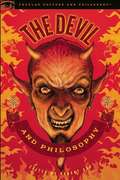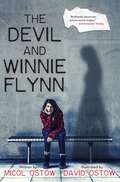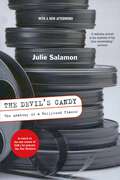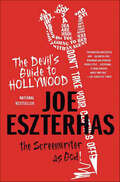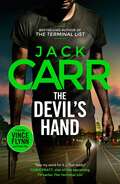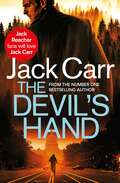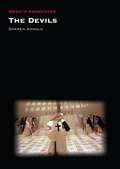- Table View
- List View
The Designer's Guide to Doing Research
by Cindy Coleman Sally AugustinAn essential introduction to applying research for busy architects and designers The competitive design market and the need to create enduring value place high demands on architects and designers to expand their knowledge base to be able to digest and utilize multiple sources of information. Expected by their clients to be well versed on all aspects of a project, time-constrained architects and designers need quick responses in the face of daily challenges. As a result, these professionals must-more than ever-rely on, and apply, readily accessible information culled from sound research to gain a competitive advantage. The Designer's Guide to Doing Research serves as an introductory guide on the general concepts and processes that define "good" research. Organized logically with the practical tools necessary to obtain research for all facets of the designer's workflow, this book offers: Material written in an accessible format specifically for practitioners Reliable content by experienced authors-a noted environmental psychologist and an interior design educator who is also a practitionerand writer Tools for planning, executing, and utilizing research presented in an easy-to-follow format along with case studies, sources, and applications Written for all practices and people concerned with the built environment, from architects and interior designers to facility managers, landscape architects, and urban planners, this book serves as an invaluable starting point for gathering and implementing research effectively.
The Designer's Guide to Marketing and Pricing
by Peleg Top Ilise BenunDo what you love and make money! The Designer's Guide to Marketing and Pricingwill answer all the common questions asked by designers trying to stay afloat in their creative business - and also successful designers who want to put a little more thought into their operations. Whether you're a freelancer, an aspiring entrepreneur or a seasoned small-business owner, you'll learn everything you need to know about how to market and price your services. This book shows you how to: learn which marketing tools are most effective and how to use them create a smart marketing plan that reflects your financial goals plan small actionable steps to take in reaching those financial goals determine who your ideal clients are and establish contact with them turn that initial contact into a profitable relationship for both of you talk to clients about money and the design process - without fear figure out a fair hourly rate and give an accurate estimate for a project You'll learn the ins and outs of creating and running a creative services business - the things they never taught you in school. Plus, there are useful worksheets throughout the book, so you can apply the principles and formulas to your own circumstances and create a workable business plan right away.
The Designer's Guide to Presenting Numbers, Figures, and Charts
by Sally Bigwood Melissa SporeNumbers can tell an exciting story. The trick is to know what story to tell and make it understandable. This compact, practical guide will show everyone who must design numeric data how to transform raw data into readable, relevant information.The Designer's Guide to Presenting Numbers, Figures, and Charts brings together the guidelines established over the last forty years for making effective presentations of figures, tables, and graphs. Included are the straightforward steps designers and other professionals can take to make their tables and charts the most meaningful. The authors define and discuss a range of graph types, from simple bar and pie charts to contemporary "data visualizations," offering explanations of the intended application of each. Readers will learn when to use a table, when to use a chart, which chart is best to use, and how to make all numeric presentations as comprehensible as possible. Specific topics include: Rounding numbersTable constructionChart designGuidance on numbers and page layout Color Reference and demonstration tablesPresenting figures in PowerPointOrdering numbers for decision-makingMultiple comparisonsGridsAnd more Communicating information effectively is an increasingly important skill in the digital age. People find numbers persuasive, and well-executed visual presentations of information will influence more people and even shorten meetings. Complete with a glossary and helpful exercises, this guide offers everything needed to create more-effective presentations.
The Designer's Web Handbook: What You Need to Know to Create for the Web
by Patrick McneilMake the Web Work for YouYou know how to design. But you can increase your value as a designer in the marketplace by learning how to make that design function on the web. From informational sites to e-commerce portals to blogs to mobile apps, The Designer's Web Handbook helps any designer understand the full life cycle of a digital product: idea, design, production and maintenance.The best web designers create not only beautiful sites but also sites that function well--for both client and end user. Patrick McNeil, creator of the popular web design blog designmeltdown.com and author of the bestselling Web Designer's Idea Book, volumes 1 and 2, teaches you how to work with developers to build sites that balance aesthetics and usability, and to do it on time and on budget.
The Designer's Web Handbook: What You Need to Know to Create for the Web
by Patrick McneilMake the Web Work for YouYou know how to design. But you can increase your value as a designer in the marketplace by learning how to make that design function on the web. From informational sites to e-commerce portals to blogs to mobile apps, The Designer's Web Handbook helps any designer understand the full life cycle of a digital product: idea, design, production and maintenance.The best web designers create not only beautiful sites but also sites that function well--for both client and end user. Patrick McNeil, creator of the popular web design blog designmeltdown.com and author of the bestselling Web Designer's Idea Book, volumes 1 and 2, teaches you how to work with developers to build sites that balance aesthetics and usability, and to do it on time and on budget.
The Designer's Workspace
by Douglas CaywoodThe Designer's Workspace presents an extensive resource of distinguished firms' responses to the design of their own offices. Featuring everythingfrom technical detail to interior design, it illustrates what these designers see as the major considerations for modern workplace design. This book reveals design solutions, details, and concepts that have been explored and used by design firms from around the world. From the first impressions at the Reception area and Lobby, to the appeal and diverse uses of the meeting areas, to the functionality and sleekness of the Design Studioitself, it illustrates how the designer's office can be quite unique in style, function, and character whilst also varying from culture to culture. No two designers will produce the same atmosphere. With this objective, The Designer's Workspace showcases an array of designs from the traditional to the contemporary, from the historic renovation to the new office tower and serves as a portfolio of the varied responses and solutions found to the challenge of designing the modern office.
The Designing for Growth Field Book: A Step-by-Step Project Guide (Columbia Business School Publishing Ser.)
by Jeanne Liedtka Tim OgilvieIn Designing for Growth: A Design Thinking Tool Kit for Managers (D4G), Jeanne Liedtka and Tim Ogilvie showed how design can boost innovation and drive growth. In this companion guide, also suitable as a stand-alone project workbook, the authors provide a step-by-step framework for applying the D4G toolkit and process to a particular project, systematically explaining how to address the four key questions of their design thinking approach.The field book maps the flow of the design process within the context of a specific project and reminds readers of key D4G takeaways as they work. The text helps readers identify an opportunity, draft a design brief, conduct research, establish design criteria, brainstorm, develop concepts, create napkin pitches, make prototypes, solicit feedback from stakeholders, and run learning launches. The workbook demystifies tools that have traditionally been the domain of designers—from direct observation to journey mapping, storytelling, and storyboarding—that power the design thinking process and help businesses align around a project to realize its full potential.
The Designing for Growth Field Book: A Step-by-Step Project Guide (Columbia Business School Publishing Ser.)
by Jeanne Liedtka Tim OgilvieDesigning for Growth: A Design Thinking Tool Kit for Managers (D4G) showed how organizations can use design thinking to boost innovation and drive growth. This updated and expanded companion guide is a stand-alone project workbook that provides a step-by-step framework for applying the D4G tool kit and process to a particular project, systematically explaining how to address the four key questions of the design thinking approach.In the field book, Jeanne Liedtka, Tim Ogilvie, and Rachel Brozenske guide readers through the design process with reminders of key D4G takeaways as they progress. Readers learn to identify an opportunity, draft a design brief, conduct research, establish design criteria, brainstorm, develop concepts, create napkin pitches, make prototypes, solicit feedback from stakeholders, and run learning launches. This second edition is suitable for projects in business, nonprofit, and government contexts, with all-new tools, practical advice, and facilitation tips. A new introduction discusses the relationship between strategy and design thinking.
The Detective's Companion in Crime Fiction: A Study in Sidekicks (Crime Files)
by Lucy Andrew Samuel SaundersThis book aims to establish the position of the sidekick character in the crime and detective fiction literary genres. It re-evaluates the traditional view that the sidekick character in these genres is often overlooked as having a small, generic or singular role—either to act as the foil to the detective in order to accentuate their own abilities at solving crimes, or else to simply tell the story to the reader. Instead, essays in the collection explore the representations and functions of the detective’s sidekick across a range of forms and subgenres of crime fiction. By incorporating forms such as children’s detective fiction, comics and graphic novels and film and television alongside the more traditional fare of novels and short stories, this book aims to break down the boundaries that sometimes exist between these forms, using the sidekick as a defining thread to link them together into a wider conceptual argument that covers a broad range of crime narratives.
The Determinants of Small Firm Growth: An Inter-Regional Study in the United Kingdom 1986-90 (Regions and Cities #8)
by Richard Barkham Mark Hart Graham GudginOne of the most striking trends in economic development since the 1970s has been the rising importance of the small firm. Focusing on the issues of enterprise development and the regional dimensions of small-firm growth, this book explores the literature of this area. Moving from an analysis of measures of growth to the effects of both internal and external variables - arguing that the owner-manager has a key role in the growth performance of the firm - the authors explore regional disparities in, and constraints on, growth, and make significant advances in the policy debate on understanding how faster growth can be achieved.
The Detroit Genre: Race, Dispossession, and Resilience in American Literature and Film, 1967-2023
by Vincent HaddadDetroit has an essential relationship to genre in American literature and popular culture. The contemporary formations of the suburban sitcom, the post-apocalyptic genre, the sci-fi dystopia, crime fiction, the superhero genre, and contemporary horror would not exist in the way they do today without the aesthetic material and racial history of Detroit. When DC Comics wanted to compete with Marvel and market “socially relevant” comics, especially ones dealing with issues of race, they swapped Gotham and Metropolis for Detroit. What about vampires concerned with de-industrialization, heritage conservation, and impending water wars? Must be Detroit. A story about a half-man, half-robot wrestling with what it means to be human by fighting crime? Improbably, Detroit has two. Author Vincent Haddad’s The Detroit Genre provides the first comprehensive literary and cultural investigation of the representations of Detroit in popular and literary culture. The book first establishes the concept of the “Detroit genre” that emerged in late 1960s and traces the tropes of this white-centric narrative genre in popular culture, touching on key texts including Blue Collar, Robocop, The Crow, It Follows, and Barbarian. The second part shows how Black writers, including Alice Randall, adrienne maree brown, Stephen Mack Jones, and Angela Flournoy, reclaimed and revised the Detroit genre by un-fixing Detroit narratives of dispossession, criminality, and industrial and social failure through formal experimentations on genre itself. Where Detroit has typically been painted in the news as one of three things—the center of the automotive industry; crime-ridden and in ruins; or as a “blank canvas” with limitless potential of entrepreneurship—Vincent Haddad shows that the Detroit genre in literature and film can be far more powerful than news media in narrating Black dispossession as a pragmatic, even liberal consensus. The texts studied here condition forgetfulness about Detroit’s history or expose it to a full reckoning, direct attention toward or away from the city’s agents of injustice, fetishize resilience or model resistance, and foreclose or imagine a future of Black liberation. Appealing to scholars of popular literature, media, race, and American studies, The Detroit Genre is an accessible and engaging study of the city’s influence on a wide array of genres in pop culture.
The Detroit Public Library: An American Classic (Painted Turtle)
by Barbara Madgy Cohn Patrice Rafail MerrittFor the last century, the Detroit Public Library has ranked as one of the most beautiful buildings in Detroit — an important landmark as well as a significant monument serving generations of Detroiters. The Detroit Public Library: An American Classic was born out of “Discover the Wonders,” an art and architectural tour of the main library that began in December 2013. Since the tour’s inception, around seven thousand people have visited this structural gem. The Detroit Public Library was the result of numerous requests for a book that showcases the library’s many artistic and architectural wonders. As the photographs in this book reveal, the Detroit Public Library stands as an enduring symbol of the public library, one of the most democratic institutions in America. The design of the Detroit Public Library was Cass Gilbert’s vision for Detroit’s Early Italian Renaissance-style library. This book honors his work with a chronological and photographic timeline of the conception and building of the 1921 Woodward Avenue Library, the 1963 Cass Avenue addition, and the library as it is today. The book goes through the library’s transformative years, documenting the contributions of local and national artists such as Mary Chase Perry Stratton, Gari Melchers, and John Stephens Coppin, and includes photographs of the rooms they have decorated with murals, mosaics, painted windows, bronze works, architectural elements, and ornamentation. In preparing The Detroit Public Library, the authors had two fundamental desires, as they note in their preface. The first was to celebrate the main library’s design using both historic and contemporary images, the latter contributed by a number of photographers presently working in Detroit. The second was “to share with the world the beauty and elegance of a grand building in a great city that, even through the most difficult times, has sustained one of the most magnificent neo-classical buildings in the country.” The Detroit Public Library unites the interests of history buffs, art enthusiasts, library lovers, and Detroit-area locals with a tribute to one of the city’s most impressive structures. This book will appeal to those looking to learn about the builders, the history, and the stories that brought the Detroit Public Library to fruition.
The Development of African Drama (Routledge Revivals)
by Michael EthertonOriginally published in 1982, this book explores concepts such as ‘traditional performance’ and African theatre’. It analyses the links between drama and ritual, and drama and music and diagnoses the confusions in our thought. The reader is reminded that drama is never merely the printed word, but that its existence as literature and in performance is necessarily different. The analysis shows that literature tends to replace performance; and drama, removed from the popular domain, becomes elitist. The book’s richness lies in the constantly stimulating analysis of ‘art’ theatre, as exemplified in protest plays, in African adaptations and transpositions of such classical subjects as the Bacchae and Everyman, in plays on African history, on colonialism and neo-colonialism. The final chapters argue that the form of African drama needs to evolve as the content does.
The Development of Popular Music Function in Film: From the Birth of Rock ‘n’ Roll to the Death of Disco (Palgrave Studies in Audio-Visual Culture)
by Anthony HoggThis book offers a unique examination of the development of popular music function in film. It assesses the contribution of popular music to the interpretation of the most significant films, covering the period from rock ‘n’ roll’s initial introduction at the opening of Blackboard Jungle, to the backlash against disco, which followed soon after the release of Saturday Night Fever. By dividing this period into five phases—The Classical American Musical Phase, The British Invasion Phase, The New Hollywood Alienation Phase, The Disco Phase and The Post-Disco Conservative Phase—the book pinpoints key moments at which individual developments occurred and lays out a path of expansion in popular music function. Each chapter offers close analyses of this period’s most innovative films; examines the cultural, historical, technical and industrial factors peculiar to each phase and considers the influence of these upon the specific timing of functional advances.
The Devil Finds Work: An Essay (Vintage International #1)
by James BaldwinFrom "the best essayist in this country&” (The New York Times Book Review) comes an incisive book-length essay about racism in American movies that challenges the underlying assumptions in many of the films that have shaped our consciousness. Baldwin&’s personal reflections on movies gathered here in a book-length essay are also an appraisal of American racial politics. Offering a look at racism in American movies and a vision of America&’s self-delusions and deceptions, Baldwin considers such films as In the Heat of the Night, Guess Who&’s Coming to Dinner, and The Exorcist.Here are our loves and hates, biases and cruelties, fears and ignorance reflected by the films that have entertained and shaped us. And here too is the stunning prose of a writer whose passion never diminished his struggle for equality, justice, and social change.
The Devil You Dance With: Film Culture in the New South Africa
by Audrey MccluskeySouth African film culture, like so much of its public life, has undergone a tremendous transformation during its first decade of democracy. Filmmakers, once in exile, banned, or severely restricted, have returned home; subjects once outlawed by the apparatchiks of apartheid are now fair game; and a new crop of insurgent filmmakers are coming to the fore. Compiled and edited by Audrey Thomas McCluskey, this extraordinary volume presents twenty-five in-depth interviews with established and emerging South African filmmakers such as Zola Maseko, Teboho Mahlatsi, Ntshaveni wa Luruli, and many more. The interviews capture the filmmakers' spirit, energy, and ambition as they attempt to give birth to a film culture that reflects the heart and aspirations of their diverse and emergent nation.
The Devil and Philosophy
by Robert ArpIn The Devil and Philosophy, 34 philosophers explore questions about one of the most recognizable and influential characters (villains?) of all time. From Roman Polanski's The Ninth Gate to J.R.R. Tolkien's The Silmarillion to Bram Stoker's Dracula to Darth Vader to Al Pacino's iconic performance in The Devil's Advocate, this book demonstrates that a little devil goes a long way. From humorous appearances, as in Kevin Smith's film Dogma and Chuck Palahniuk's novels Damned and its sequel Doomed, to more villanous appearances, such as Gabriel Byrne's cold outing as Satan in End of Days, The Devil in Philosophy proves that the Devil comes in many forms.Through the lenses of Jung, Kant, Kundera, Balkan, Plato, Bradwardine, Aristotle, Hume, Blackburn, Descartes, Lavey, Thoreau, and Aquinas, The Devil and Philosophy take a philosophical look at one of time's greatest characters. Are there any good arguments for the actual existence of the Devil? Does demonic evil thrive in Gotham City? Can humans really be accountable for all evil? Which truths about the Devil are actual facts? Is Milton correct, in that the Devil believes he is doing good?
The Devil and Winnie Flynn
by Micol Ostow"A love letter to all your favorite horror movie classics . . . Micol Ostow's razor sharp writing and David Ostow's wonderful illustrations combine for an unforgettable reading experience."—Courtney Summers, author of This Is Not a Test and All the RageWinnie Flynn doesn&’t believe in ghosts. (Though she wouldn&’t mind a visit from her mom, explaining why she took her own life.) When her mysterious aunt Maggie, a high-profile TV producer, recruits Winnie to spend a summer working as a production assistant on her current reality hit, Fantastic, Fearsome, she suddenly finds herself in the one place her mother would never go: New Jersey.New Jersey&’s famous Devil makes perfect fodder for Maggie&’s show. But as the filming progresses, Winnie sees and hears things that make her think that the Devil might not be totally fake after all. Things that involve her and her family. Things about her mother&’s death that might explain why she&’s never met Aunt Maggie until now.Winnie soon discovers her family&’s history is deeply entwined with the Devil&’s. If she&’s going to make it out of the Pine Barrens alive, she might have to start believing in what her aunt is telling her—and find out what she isn&’t.
The Devil's Atlas: An Explorer's Guide to Heavens, Hells and Afterworlds
by Edward Brooke-HitchingPacked with strange stories and spectacular illustrations, The Devil's Atlas leads you on an adventure through the afterlife, exploring the supernatural worlds of global cultures to form a fascinating traveler's guide quite unlike any other. From the author of the critically acclaimed bestsellers The Phantom Atlas, The Sky Atlas, and The Madman's Library comes a unique and beautifully illustrated guide to the heavens, hells, and lands of the dead as imagined throughout history by cultures and religions around the world. Packed with colorful maps, paintings, and captivating stories, The Devil's Atlas is a compelling tour of the geography, history, and supernatural populations of the afterworlds of cultures around the globe. Whether it's the thirteen heavens of the Aztecs, the Chinese Taoist netherworld of "hungry ghosts," Islamic depictions of Paradise, or the mysteries of the Viking mirror world, each is conjured through astonishing images and a highly readable trove of surprising facts and narratives, stories of places you'd hope to go, and those you definitely would not. A traveler's guide to worlds unseen, here is a fascinating visual chronicle of our hopes, fears, and fantasies of what lies beyond. DISCOVER THE BEYOND: From the depths of underworlds to the heights of heavens and everywhere else a life after death may be spent, this atlas explores the geography, history, and supernatural populations of the afterworlds of global mythologies. A GLOBAL SURVEY: From the demon parliament of the ancient Maya, to the eternal globe-spanning quest to find the Earthly Paradise, to the "Hell of the Flaming Rooster" of Japanese Buddhist mythology (in which sinners are tormented by an enormous fire-breathing cockerel), The Devil's Atlas gathers together a wonderful variety of beliefs and representations of life after death. UNUSUAL AND UNSEEN: These afterworlds are illustrated with an unprecedented collection of images. They range from the marvelous "infernal cartography" of the European Renaissance artists attempting to map the structured Hell described by Dante and the decorative Islamic depictions of Paradise to the various efforts to map the Garden of Eden and the spiritual vision paintings of nineteenth-century mediums. EXPERT AUTHOR: Edward Brooke-Hitching is a master of taking visually–driven deep dives into unusual historical subjects, such as the maps of imaginary geography in The Phantom Atlas, ancient pathways through the stars in The Sky Atlas, and the literary oddities lining the metaphorical shelves of The Madman's Library. Perfect for:Obscure history and mythology enthusiastsAnyone with an interest in the occultSpiritual curiosity seekersMap lovers
The Devil's Candy: The Anatomy Of A Hollywood Fiasco
by Julie Salamon"A definitive portrait of the madness of big-time moviemaking" (Newsweek), now the basis for the new season of TCM's hit podcast, "The Plot Thickens" and featuring a new afterword by the authorWhen Brian De Palma agreed to allow Julie Salamon unlimited access to the film production of Tom Wolfe's best-selling book The Bonfire of the Vanities, both director and journalist must have felt like they were on to something big. How could it lose? But instead Salamon got a front-row seat at the Hollywood disaster of the decade. She shadowed the film from its early stages through the last of the eviscerating reviews, and met everyone from the actors to the technicians to the studio executives. They'd all signed on for a blockbuster, but there was a sense of impending doom from the start--heart-of-gold characters replaced Wolfe's satiric creations; affable Tom Hanks was cast as the patrician heel; Melanie Griffith appeared mid-shoot with new, bigger breasts. With a keen eye and ear, Salamon shows us how the best of intentions turned into a legendary Hollywood debacle.The Devil's Candy joins John Gregory Dunne's The Studio, Steven Bach's Final Cut, and William Goldman's Adventures in the Screen Trade as a classic for anyone interested in the workings of Hollywood. With a new afterword profiling De Palma ten years after the movie's devastating flop (and this book's best-selling publication), Julie Salamon has created a riveting insider's portrait of an industry where art, talent, ego, and money combine and clash on a monumental scale.
The Devil's Charter: A Tragedie, Conteining The Life And Death Of Pope Alexander The Sixt (classic Reprint) (Globe Quartos)
by Barnabe BarnesFirst Published in 1999. Routledge is an imprint of Taylor & Francis, an informa company.
The Devil's Guide to Hollywood: The Screenwriter as God!
by Joe EszterhasIn The Devil's Guide to Hollywood, bestselling author and legendary bad-boy screenwriter Joe Eszterhas tells everything he knows about the industry, its players and screenwriting itself—from the first blank sheet of paper in the Olivetti to the size of the credit on the one-sheet. "There's just one hunk of funny anecdote after another, quotes from everyone who ever mattered in the movie biz, and the thing is jam-packed with screenwriterly advice. Plus it's hilariously funny, ribald, sexy and brilliant."—Liz SmithOften practical and always entertaining, The Devil's Guide to Hollywood distills everything one of Hollywood's most accomplished screenwriters knows about the business, from writing advice to negotiation tricks, from the wisdom of past players to the feuds of current ones. Eszterhas has selected his personal pantheon of the most loved and loathed players in the business and treats the reader to a treasure trove of stories, quotes and wisdom from those luminaries, who include William Goldman (loathes) and Zsa Zsa Gabor (loves). The Devil's Guide to Hollywood could only have been written by someone who loves the business as much as Eszterhas does—but who also has its number."Eszterhas delivers a dishy, catty mix of reminiscences and Hollywood trivia…his forte is skewering sycophants and phonies in this opinionated showcase of the underside of Hollywood life."—Publishers Weekly
The Devil's Hand: James Reece 4 (Terminal List #4)
by Jack CarrNEW YORK TIMES AND USA TODAY BESTSELLING AUTHORThe fourth thriller in the &“so powerful, so pulse-pounding, so well-written&” (Brad Thor, #1 New York Times bestselling author) Terminal List series follows former Navy SEAL James Reece as he is entrusted with a top-secret CIA mission of retribution twenty years in the making. It&’s been twenty years since 9/11. Two decades since the United States was attacked on home soil and embarked on twenty years of war. The enemy has been patient, learning, and adapting. And the enemy is ready to strike again. A new president offers hope to a country weary of conflict. He&’s a young, popular, self-made visionary…but he&’s also a man with a secret. Halfway across the globe a regional superpower struggles with sanctions imposed by the Great Satan and her European allies, a country whose ancient religion spawned a group of ruthless assassins. Faced with internal dissent and extrajudicial targeted killings by the United States and Israel, the Supreme Leader puts a plan in motion to defeat the most powerful nation on earth. Meanwhile, in a classified facility five stories underground, a young PhD student has gained access to a level of bioweapons known only to a select number of officials. A second-generation agent, he has been assigned a mission that will bring his adopted homeland to its knees. With Jack Carr&’s signature &“absolutely intense&” (Chuck Norris) writing and &“gripping authenticity&” (The Real Book Spy), The Devil&’s Hand is a riveting and timely thriller that will leave you gasping for breath.
The Devil's Hand: the GRIPPING James Reece thriller now on Amazon Prime (Terminal List Ser. #4)
by Jack Carr**THE NEW YORK TIMES BESTSELLER – NOW AN AMAZON PRIME TV SERIES STARRING CHRIS PRATT** If you loved Lee Child's Jack Reacher, Peter James's Roy Grace or Michael Connelly's Mickey Haller, you will love The Devil's Hand and the James Reece series!'Take my word for it, James Reece is one rowdy motherf***er. Get ready!' Chris Pratt 'This is seriously good . . . the suspense is unrelenting, and the tradecraft is so authentic the government will probably ban it –so read it while you can!' Lee Child 'With a particular line in authentic tradecraft, this fabulously unrelenting thrill-ride was a struggle to put down' Mark DawsonIt has been two decades since 9/11. The enemy has been patient. The enemy has been learning. The enemy has been adapting. The enemy is ready to strike again . . . Former Navy SEAL James Reece must embark on a top-secret CIA mission of retribution twenty years in the making in this riveting and timely thriller that will leave you gasping for breath.Praise for Jack Carr . . . 'Gritty, raw and brilliant!' Tom Marcus &‘So powerful, so pulse-pounding, so well-written – rarely do you read a debut novel this damn good&’ Brad Thor 'Carr writes both from the gut and a seemingly infinite reservoir of knowledge in the methods of human combat. Loved it!' Chris Hauty 'A powerful, thoughtful, realistic, at times terrifying thriller that I could not put down. A terrific addition to the genre, Jack Carr and his alter-ego protagonist, James Reece, continue to blow me away' Mark Greaney 'Thrilling' Publishers Weekly
The Devils (Devil's Advocates)
by Darren ArnoldUndoubtedly the most notorious title in director Ken Russell’s controversial filmography, The Devils (1973) caused a real furor on its initial theatrical release, only to largely disappear for many years. This Devil’s Advocate considers the film’s historical context, as the timing of the first appearance of The Devils is of particular importance, its authorship and adaptation (Russell’s auteur reputation aside, the screenplay is based on John Whiting’s 1961 play of the same name, which was in turn based on Aldous Huxley’s 1952 book The Devils of Loudun), and its generic hybridity. Darren Arnold goes on to examine the themes prevalent in the film—this is the only film of Russell’s which the director considered to be political—and considers the representation of gender and sexuality, gender fluidity, and how sex and religion clash to interesting and controversial effect. He concludes by revisiting the film’s censorship travails and the various versions of The Devils that have appeared on both big and small screens, and the film’s legacy and influence.
